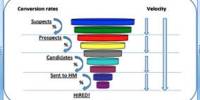The 360-degree evaluation is a common tool in human resource management. Simply put, it is a mechanism for evaluating someone’s performance based on feedback from everyone with whom the individual comes in contact — supervisors, coworkers, partners, subordinates, the general public. It is a method of collecting input from many sources in an employee’s environment.
In the more traditional method of performance appraisal, supervisors meet with employees one-to-one to discuss performance. By contrast, the 360-degree method uses confidential input from many people who can truly respond to how an employee performs on the job. The supervisor and employee meet to discuss the feedback received.
This type of feedback helps employees see themselves as others see them and allows them to seriously examine their behavior. It can reveal areas in which employees are performing particularly well and those areas in which there is room for improvement. It provides information of which neither the employee nor the supervisor may be aware. Specific input allows employees to adjust their performance.
The most challenging aspect of the 360-degree evaluation is the evaluators’ concern about confidentiality. When implementing this type of evaluation, it’s best to assure other employees that what they share will remain strictly confidential. Likewise, explain to each employee that he will be evaluated by many people, including those who know his work best.
Typically, employees will find this methodology to be more fair. When they consider this process as opposed to being evaluated by an individual supervisor who has limited knowledge of what they do, they will begin to see the value in this type of evaluation. They will conclude that the 360-degree feedback is more accurate and equitable than other traditional approaches and puts all employees on a level playing field.
Most people are not able to see clearly how their performance is either enhancing the work situation for others or detracting from it. This performance evaluation method can help reveal these areas and allow us to improve the way we do our job, thereby creating greater harmony and better productivity in the workplace. The 360-degree evaluation will help employees identify their strengths so they can build on them at the same time it addresses their skill gaps. It is a process that leads to continuous learning, team building, growing self-confidence and improved productivity.
While this can be a powerful and positive tool when tied to strategic goals and individual development, you might consider doing more research on the subject before implementation.
















